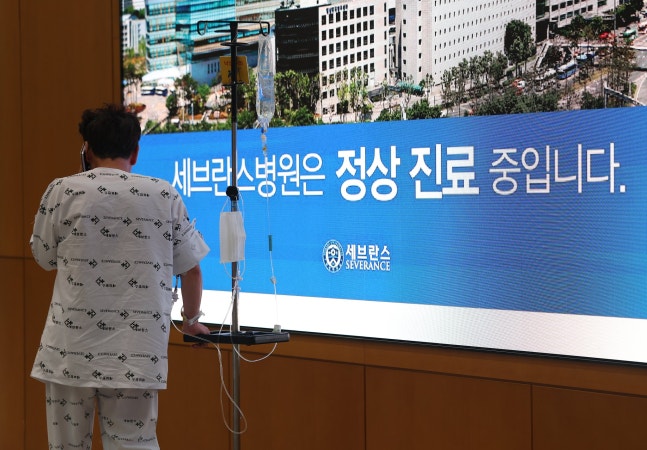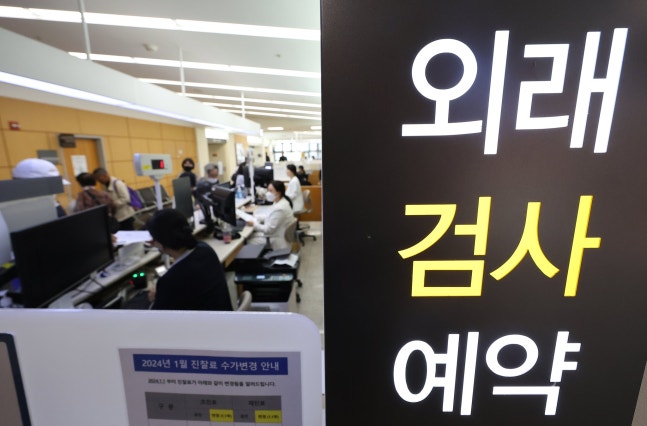
Doctors at Severance Hospital continue their indefinite strike on November 30, with a message displayed on a monitor inside the hospital in Seoul’s Seodaemun-gu saying ‘Severance Hospital is operating normally.’ Yonhap News

Patients waiting for medical treatment at a large hospital in downtown Seoul. Yonhap News
‘ Doctors’ strike with high intensity medical readjustment to protect patients. ‘
‘ A day before the strike (4th), professors at Seoul Asan Hospital released a statement with such content. Instead of an indefinite strike, the professors’ task force referred to it as ‘medical readjustment.’ They aim to reduce mild patient care and focus on severe and emergency patient treatment by streamlining the system. In the information released on the 17th last month, it was clearly stated as a “strike,” but now it is called medical readjustment.’
‘The task force emphasized that as of the 4th, major surgeries will decrease by 29% compared to the previous week, and outpatient visits will also decrease by 17.2%. They also expressed the need for outpatient reservations to be deferred so that tertiary comprehensive hospitals can treat the patients. Rather than medical readjustment, it is not much different from a partial strike.’
‘The return of medical treatment at Seoul National University Hospital, delayed decisions at Samsung Seoul Hospital and Seoul St. Mary’s Hospital seemed to be sluggish. Severance Hospital went on an indefinite strike on the 27th of last month, and Korea University Hospital and Chungbuk University Hospital announced and moved forward with their strikes this month.’
‘A somewhat fortunate point is that they initially mentioned a complete strike but later lowered the tone. They claimed that they will not neglect essential treatments like severe and emergency cases. However, just avoiding expressions like ‘indefinite’ or ‘strike’ doesn’t make the treatment interruptions disappear. On the contrary, hospitals like Severance Hospital are closer to being “almost a strike in appearance.” In fact, it is a situation of normal medical treatment. It can also be seen as losing momentum internally. The paradoxical situation brought about by a strike that did not gain social support.’
‘Amidst this confusion, patients anxiously wonder if they will suddenly receive delayed treatment schedule notifications. Cho Mo, a guardian who came to Severance Hospital with her husband undergoing treatment for stomach cancer, said, “Patients who need continuous treatment can’t help but feel anxious when hearing news of strikes.”‘
‘Each hospital’s task force is determined to continue fighting until government policies change and demands of specialization such as the expansion of medical school admissions until 2025 are met. However, a blank expansion is impossible. Even though professors may be aware of this, they persist. Patients are anxious. Kim Jae-hak, the chairman of the Korea Rare and Intractable Diseases Association, said, “Patients who only face doctors’ decisions can only be ‘B’ types,” adding that, especially when news of strikes from the top 5 hospitals sought by rare disease patients breaks, they become very anxious. Appointments for medical treatment are gradually piling up.’
‘While fully understanding the professors’ grievances about medical reform and accumulated fatigue, any argument outside the treatment scene is hard to welcome. There is nothing as dishonorable as a “sudden strike.” By listening to the voice of patient respect, one can gain greater support. Kwak Jeom-soon, the chairwoman of the Korea Breast Cancer Patient Federation, said, “I know well that medical staff work hard at the scene. That’s why I feel even more grateful to those who keep the hospital going, even if they get criticized.”‘

